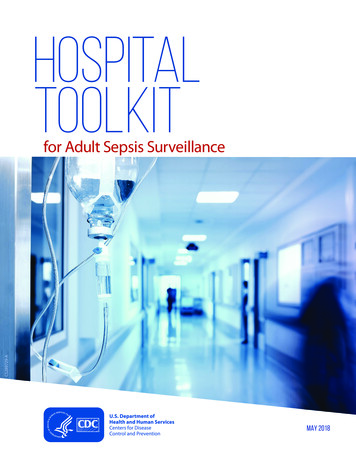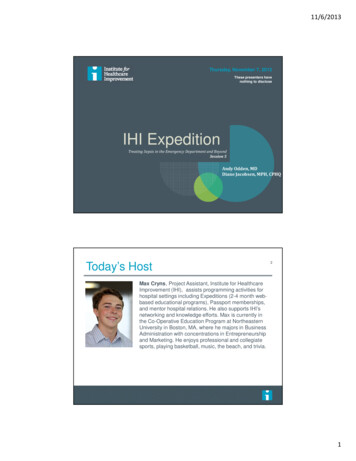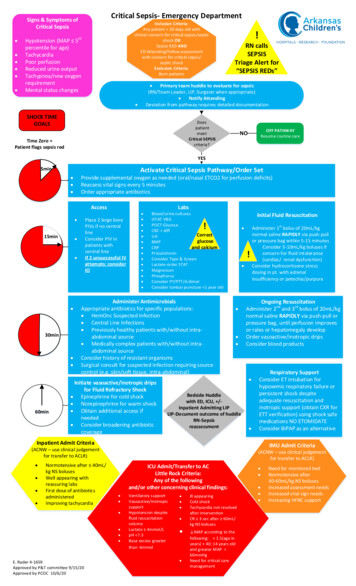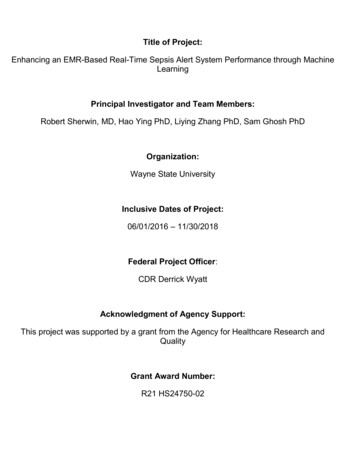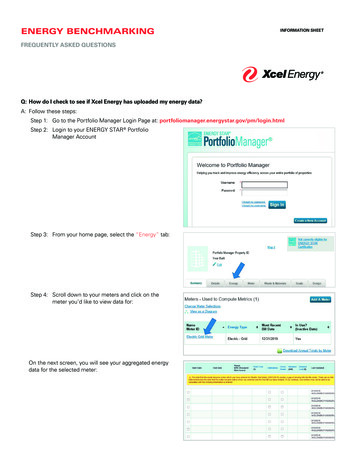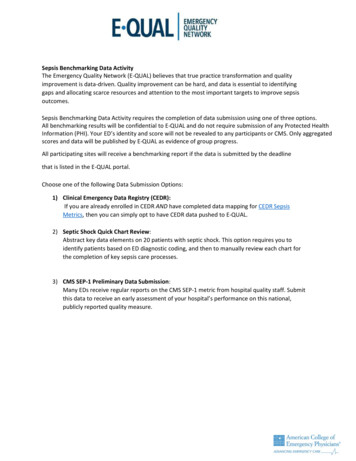
Transcription
Sepsis Benchmarking Data ActivityThe Emergency Quality Network (E-QUAL) believes that true practice transformation and qualityimprovement is data-driven. Quality improvement can be hard, and data is essential to identifyinggaps and allocating scarce resources and attention to the most important targets to improve sepsisoutcomes.Sepsis Benchmarking Data Activity requires the completion of data submission using one of three options.All benchmarking results will be confidential to E-QUAL and do not require submission of any Protected HealthInformation (PHI). Your ED’s identity and score will not be revealed to any participants or CMS. Only aggregatedscores and data will be published by E-QUAL as evidence of group progress.All participating sites will receive a benchmarking report if the data is submitted by the deadlinethat is listed in the E-QUAL portal.Choose one of the following Data Submission Options:1) Clinical Emergency Data Registry (CEDR):If you are already enrolled in CEDR AND have completed data mapping for CEDR SepsisMetrics, then you can simply opt to have CEDR data pushed to E-QUAL.2) Septic Shock Quick Chart Review:Abstract key data elements on 20 patients with septic shock. This option requires you toidentify patients based on ED diagnostic coding, and then to manually review each chart forthe completion of key sepsis care processes.3) CMS SEP-1 Preliminary Data Submission:Many EDs receive regular reports on the CMS SEP-1 metric from hospital quality staff. Submitthis data to receive an early assessment of your hospital’s performance on this national,publicly reported quality measure.
Sepsis Quick Chart Review Data Submission GuideThe following definitions and instructions are to be used for data submission for the Emergency Quality Network (E‐QUAL) Sepsis Quick Chart Review Option. Note these definitions may slightly differ from those used for the ClinicalEmergency Data Registry (CEDR) or SEP‐1 data submission options.Step 1: Identify 20 cases for manual reviewCases should be identified for each Benchmarking Activity based on Emergency Department diagnostic coding. Thesecases can be queried from electronic health records, billing data, or with the assistance of your revenue cyclemanagement company. A detailed list of ICD‐9, ICD‐10, or SNOMED codes that can be used to identify cases is availablefor download.If your site does not have 20 cases within the defined 3 month period, you can increase the data collection period to 6months to meet the 20 case requirement.Step 2: Manually abstract numerator elements from each patient chartData ElementExclusion ReasonsInitial Lactate Performed(Yes/No)Initial lactate valueBlood Cultures Before Antibitocis(Yes/No)Broad Spectrum Antibiotics(Yes/No)30cc/kg IV fluid bolus(Yes/No)Received Vasopressors(Yes/no)Repeat Lactate Performed in ED(Yes/No)Repeat Lactate ValueDies (in‐hospital)(Yes/No)DefinitionA drop‐down list of exclusions aligned with the ClinicalEmergency Data Registry (CEDR) are available for selection if acase does not meet criteria. No additional data abstraction isrequired on excluded patients.Indicate if any form of serum lactate testing was performedduring the ED visit. This may include point of care or centrallaboratory testing.If performed, report actual initial lactate result in mmol/L.Indicate if at least one blood culture was ordered prior toadministration of antibiotics during the ED visit.Indicate if broad spectrum antibiotics were ordered during theED visit.Indicate if patient had 30/cc kg of any intravenous fluidsordered during the ED visit.Indicate if patient received any vasopressor medication duringthe ED visit regardless of indication. Vasopressor medicationsinclude epinephrine, norepinephrine, dopamine, anddobutamine.Indicate if repeat lactate was performed if initial lactate value 2mmol/L. If no initial lactate performed then leave blank. Ifinitial lactate 2mmol/L then leave blank.If performed, report actual report lactate result in mmol/L.Indicate if patient died during the same hospital stayregardless of day of hospitalization.
Quick Chart Review – About the Metrics Initial Lactate Performed:Numerator: Patients who had an initial lactate resulted.Severe Sepsis and Septic Shock Denominator: Patients with ED diagnosis or clinical impression consistent witheither septic shock or severe sepsis or infection with hypotension. This definition includes 984 ICD-10 infectioncodes, a refined update from ACEP Clinical Emergency Data Registry (CEDR) quality measures. Broad Spectrum Antibiotics: (were antibiotics administered?)Numerator: Patients who received antibiotics (broad spectrum or targeted antibiotic therapy)Denominator: Septic Shock and Severe Sepsis Denominator defined above. Blood Cultures Before Antibiotics: (were blood cultures drawn before antibiotics?)Numerator: Patients who had at least one blood culture drawn before antibiotics were administered.Denominator: Septic Shock and Severe Sepsis Denominator defined above. 30 cc/kg IV Fluids: (was the patient adequately fluid resuscitated?)Numerator: Completed fluid resuscitation with 30 cc/kg crystalloid fluidsSeptic Shock Denominator: Septic Shock and Severe Sepsis Denominator defined above. Received Vasopressors: (were vasopressors initiated?)Numerator: Patients with vasopressors initiatedDenominator: Septic Shock and Severe Sepsis Denominator defined above Repeat Lactate Performed:Numerator: Patients with a second (repeat) lactate obtained within 6 hours of initial presentation.Denominator: Septic Shock and Severe Sepsis Denominator defined above AND initial lactate 2. Lactate Clearance 10%: (was the repeat lactate improved by at least 10%)Numerator: Patients with repeat lactate at least 10% lower than initial lactate.Denominator: Septic Shock and Severe Sepsis Denominator defined above AND initial lactate 2 AND repeatlactate obtained.
Step 3: Use “Add New Row” to complete 20 manual chart reviews including excluded patients
Step 4: Click “Complete this activity” to submit results for benchmarking report generation
The Emergency Quality Network (E-QUAL) believes that true practice transformation and quality improvement is data-driven. Quality improvement can be hard, and data is essential to identifying gaps and allocating scarce resources and attention to the most important targets to improve sepsis outcomes. Sepsis Benchmarking Data Activity requires .
